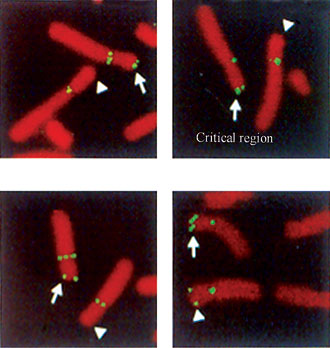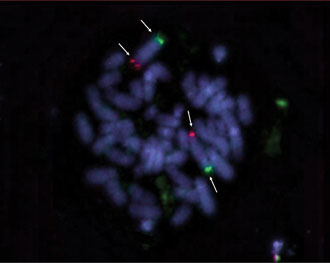


FLUORESCENT IN SITU HYBRIDIZATION ANALYSIS
OF CHROMOSOMAL MICRO-DUPLICATIONS AND
MICRO-DELETIONS IN CLINICAL GENETICS
Sarri C*
*Corresponding Author: Dr. Catherine Sarri, Genetics Department, Institute of Child Health, in “Aghia Sophia” Children’s Hospital, Thivon and M. Asias, Goudi, 115 27 Athens, Greece; Tel: +3 0 210 7467789; Fax: +3 0 210 7700111; E-mail: inchildh@otenet.gr
page: 73
|
|
NEW MICRO-DELETION SYNDROME?
During the last few years, new cases with certain micro-deletions and micro-duplications have been described, revealed by FISH analysis and attributed to the subtelomeric regions of the chromosomes. New genetic syndromes are being added to the already existing catalogue of micro-deletion and micro-duplication syndromes. Thus far, at least 20 cases have been published which can be attributed to a terminal 22q13 deletion syndrome, and may represent a recognizable phenotype with the following main features: normal or advanced growth, significantly delayed speech, pervasive behaviors, and minor facial dysmorphism [37].
Subtelomeres. Subtelomeric DNA probes identify DNA regions at a distance of 30-450 kb from the very end of the chromosome. Subtelomeric abnormalities are found in 7-10% of patients with a positive family history, dysmorphic features and mild or severe mental retardation of unknown origin [38]. Specific phenotypes for 1pter [39], 1qter (40) and 2qter [41,42] micro-deletions are recognized in many genetic centers (Fig. 5). Research projects of couples with more than five spontaneous abortions and normal karyotypes are in progress [43].
Subtelomeres That are Available. Ready to use DNA subtelomeric probes are sold for 41 out of 48 human chromosome subtelomeres. The subtelomeric probes of the short (p) arms of the five acrocentric chromosomes are not available, while the subtelomeric probes of the short and long arms of the X and Y chromosomes have the same sequence, so we cannot distinguish them.
Basic Rules for the Study of Micro-Deletions and Micro-Duplications in Human Chromosomes. 1) Careful selection of the patients from the clinical geneticist. 2) Good knowledge and experience of the FISH technique by a responsible cytogeneticist. 3) A laboratory equipped with FISH probes, fluorescent microscope with special filters, and automated analysis FISH system. 4) A molecular geneticist with good knowledge and experience and who might proceed to molecular analysis if this is needed.
Figure 4. a, b and c: Wolf syndrome with a micro-deletion; d: Wolf syndrome with a micro-duplication.

Figure 5. Chromosome 5 subtelomeres.

Table 1. Syndromes with micro-duplications.
Syndromes with
Micro-Duplications |
Chromosomal
Region |
Charcot-Marie-Tooth type 1A |
17(p11.2) |
Down’s with a normal karyotype |
21(q21-q22.1) |
Smith-Magenis (10% of patients) |
17(p11.2) |
Beckwith-Wiedemann |
11(p15.5) |
Table 2. Syndromes with micro-deletions.
Syndromes with
Micro-Deletions |
Chromosomal
Region |
Williams-Beuren |
7(q11.23) |
Di-George (CATCH 22) |
22(q11.2) |
Velocardiofacial (CATCH 22) |
22(q11.2) |
Angelman |
15(q11.2-q12) |
Prader-Willi |
15(q11.2-q12) |
Pitt-Rogers-Danks |
4(p16.3) |
Wolf-Hirschhorn |
4(p16.3) |
Miller-Dieker |
17(p13.3) |
Cri-du-Chat |
5(p15.2) |
Smith-Magenis (90% of patients) |
17(p11.2) |
Steroid sulfatase deficiency |
X(p22.3) |
Kallmann |
X(p22.3) |
|
|
|
|



 |
Number 27
VOL. 27 (2), 2024 |
Number 27
VOL. 27 (1), 2024 |
Number 26
Number 26 VOL. 26(2), 2023 All in one |
Number 26
VOL. 26(2), 2023 |
Number 26
VOL. 26, 2023 Supplement |
Number 26
VOL. 26(1), 2023 |
Number 25
VOL. 25(2), 2022 |
Number 25
VOL. 25 (1), 2022 |
Number 24
VOL. 24(2), 2021 |
Number 24
VOL. 24(1), 2021 |
Number 23
VOL. 23(2), 2020 |
Number 22
VOL. 22(2), 2019 |
Number 22
VOL. 22(1), 2019 |
Number 22
VOL. 22, 2019 Supplement |
Number 21
VOL. 21(2), 2018 |
Number 21
VOL. 21 (1), 2018 |
Number 21
VOL. 21, 2018 Supplement |
Number 20
VOL. 20 (2), 2017 |
Number 20
VOL. 20 (1), 2017 |
Number 19
VOL. 19 (2), 2016 |
Number 19
VOL. 19 (1), 2016 |
Number 18
VOL. 18 (2), 2015 |
Number 18
VOL. 18 (1), 2015 |
Number 17
VOL. 17 (2), 2014 |
Number 17
VOL. 17 (1), 2014 |
Number 16
VOL. 16 (2), 2013 |
Number 16
VOL. 16 (1), 2013 |
Number 15
VOL. 15 (2), 2012 |
Number 15
VOL. 15, 2012 Supplement |
Number 15
Vol. 15 (1), 2012 |
Number 14
14 - Vol. 14 (2), 2011 |
Number 14
The 9th Balkan Congress of Medical Genetics |
Number 14
14 - Vol. 14 (1), 2011 |
Number 13
Vol. 13 (2), 2010 |
Number 13
Vol.13 (1), 2010 |
Number 12
Vol.12 (2), 2009 |
Number 12
Vol.12 (1), 2009 |
Number 11
Vol.11 (2),2008 |
Number 11
Vol.11 (1),2008 |
Number 10
Vol.10 (2), 2007 |
Number 10
10 (1),2007 |
Number 9
1&2, 2006 |
Number 9
3&4, 2006 |
Number 8
1&2, 2005 |
Number 8
3&4, 2004 |
Number 7
1&2, 2004 |
Number 6
3&4, 2003 |
Number 6
1&2, 2003 |
Number 5
3&4, 2002 |
Number 5
1&2, 2002 |
Number 4
Vol.3 (4), 2000 |
Number 4
Vol.2 (4), 1999 |
Number 4
Vol.1 (4), 1998 |
Number 4
3&4, 2001 |
Number 4
1&2, 2001 |
Number 3
Vol.3 (3), 2000 |
Number 3
Vol.2 (3), 1999 |
Number 3
Vol.1 (3), 1998 |
Number 2
Vol.3(2), 2000 |
Number 2
Vol.1 (2), 1998 |
Number 2
Vol.2 (2), 1999 |
Number 1
Vol.3 (1), 2000 |
Number 1
Vol.2 (1), 1999 |
Number 1
Vol.1 (1), 1998 |
|
|

